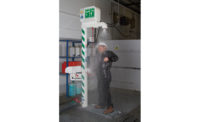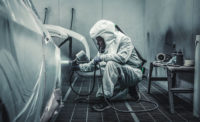Conduct a hazard assessment as the first step in determining the needed features of eye protection devices in your workplace. Hazards will fall into the basic categories of impact, splash, and optical radiation. Choosing the right protection for each of these hazards is critical because a wrong choice could lead to serious injury.
Impact hazards
The most common need for eye protection is impact protection, which includes flying particles, explosions, and other hazards. Safety spectacles with a clear lens are the most common choice for impact protection.Spectacles: When choosing a safety spectacle, whether plano (non-prescription) or prescription, choose one that offers side protection as required by OSHA 29 CFR-1910.133 “Eye/Face Protection.” Also, consider the fit of a “universal” fitting spectacle or choose one with fit adjustment features. Another point of consideration is the lens coating. Different manufacturers offer different types of lens coatings that may offer abrasion resistance, chemical attack resistance, static dissipation, or anti-fog features.
Safety spectacles usually provide satisfactory protection for most impacts, but there are circumstances, such as a fragmenting grinding wheel, when a spectacle doesn’t provide adequate protection. When greater impact protection is needed, goggles and/or faceshields should be used along with safety spectacles.
Goggles: Safety goggles are larger and cover more of the orbital area of the eye so they offer more protection than spectacles, and should be used whenever there is a need for a higher level of impact protection.
Different types of goggles include flexible goggles, where the shroud or mask portion is made of a soft and comfortable PVC or rubber; cup goggles that are rigid; and the new hybrid type, which is a modified spectacle with a secondary adapter that complies with the requirements of a goggle.
If you need to wear a goggle over prescription spectacles, choose one that completely covers the spectacle without applying excess pressure. Keep in mind that impact goggles usually have direct ventilation, which means dust will take a direct path to the eyes. In this case, be sure to use an indirect ventilation goggle, such as a splash goggle.
Faceshields: Since faceshields include a large lens or window attached to a headgear or a hard hat, they protect a portion of the face along with the eyes. Some are designed to include protection to the neck, side of face, portion of the head and/or ears. While they provide high levels of impact protection, they should never be worn alone. Use faceshields in conjunction with safety spectacles and/or goggles.
Splash hazards
A splash can be defined as a spatter or spray of a hot, cold, or hazardous liquid, a fine powder, or a mist. Most types of impact protection and safety spectacles are not the right choice for protection from splash or dust hazards. Spectacles offer limited coverage and protection from splashes.Splash goggles: The most common eye protection device for a splash is a chemical splash goggle with indirect ventilation, which allows air to flow into and out of a goggle but doesn’t provide a direct path to the eyes from a powder, dust, or liquid. Due to the limited ventilation within a splash goggle, try to choose a goggle lens with an anti-fog coating to help eliminate moisture condensation from obstructing vision.
Faceshields: Because splash goggles protect only the eye area, faceshields offer increased coverage against splashes. But remember they should always be worn with splash goggles under them to provide a high level of protection from splashes.
Faceshield windows come in many materials,
so analyze the options and choose the material
best suited to offer protection from the particular hazardous splash.
Optical radiation
Optical radiation normally includes ultraviolet, visible, and infrared radiation. If the intensity of any of these three exceeds the maximum exposure levels that the eye can withstand, eye injury can result.Key to protection from these elements is choosing the proper filtering lens. There are specific filtering lenses available to protect the eye from almost any type of optical radiation a worker might encounter. Just any dark lens is not the right eye protection for the job. Once the hazard is identified, the proper device needs to be chosen. Spectacles and goggles with filtering lenses are often sufficient, but if radiation levels are hazardous enough to cause skin damage, faceshields should be used in conjunction with a spectacle and/or goggle.
Choosing a device that is comfortable and looks good on your employees is just as important as choosing the right type of protection for each hazard. Workers usually take for granted the safety features of the chosen protection and concern themselves with how they look and feel wearing the device. So, three factors — comfort, fit and style — usually determine whether or not workers consistently wear eye protection.
Sidebar: Five reminders
This article offers a quick overview of how to choose the right protection for each situation. However, in choosing the right eye protection, no article can replace common sense, sound judgment, and the use of the following guiding principles:- Always conduct an eye safety hazard assessment for every job.
- Try to use engineering controls to eliminate or dilute the eye hazard.
- Use the ANSI Z87.1-1989 standard “Practice for Occupational and Educational Eye & Face Protection” selection chart.
- Read the manufacturer’s warning labels.
- As a final source of information and guidance, call the manufacturer of the eye or face protection device. Manufacturers have extensive information and resources to help you determine the right eye protection for the job.


